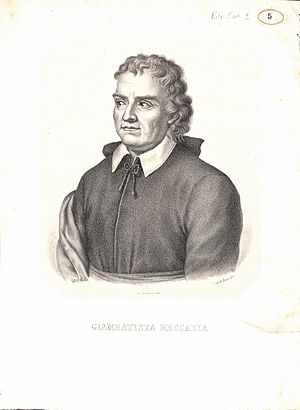Giovanni Battista Beccaria facts for kids
Quick facts for kids
Giovanni Battista Beccaria
|
|
|---|---|

Giovanni Battista Beccaria
|
|
| Born |
Francesco Ludovico Beccaria
October 3, 1716 Mondovì, Duchy of Savoy
|
| Died | 27 May 1781 (aged 64) |
| Nationality | Italian |
| Known for | Elettricismo artificiale e naturale libri due |
| Parent(s) | Giovanni Battista Beccaria Anna Maria Ingalis |
| Scientific career | |
| Fields | Experimental physics |
| Institutions | University of Turin |
| Notable students | Joseph-Louis Lagrange |
| Influences | |
| Influenced | |
Giovanni Battista Beccaria (born October 3, 1716 – died May 27, 1781) was an Italian physicist. He was a member of the Royal Society in London. He wrote many articles about electricity for a science magazine called Phil. Trans..
Beccaria was a close friend and pen pal of Benjamin Franklin, a famous American scientist. Beccaria's work also inspired other important scientists like Alessandro Volta and Luigi Galvani. He helped spread knowledge about electricity through his experiments and writings.
In 1753, Beccaria published an important book on electricity called "Elettricismo artificiale e naturale libri due". Benjamin Franklin was so impressed that he helped get it translated into English. Beccaria also helped classify different types of light from electrical discharges. He collected information about atmospheric electricity (electricity in the air). He even designed an electrical thermometer. Franklin praised Beccaria for organizing the many scattered ideas about electricity. Another scientist, Joseph Priestly, called Beccaria the "great Italian genius."
Beccaria's Life and Discoveries
Giovanni Battista Beccaria was born in Mondovì, Italy, in 1716. When he was 16, he joined a religious group called the Piarists. He studied and later taught subjects like grammar and math. He also became very good at mathematics.
Beccaria became a professor of experimental physics (physics based on experiments). He taught first in Palermo and then in Rome. Because he was such a good teacher, he was made a physics professor at the University of Turin in 1748. He also taught young princes. He spent most of his life in Turin.
In Turin, he focused on studying atmospheric electricity. He used kites, rockets, and iron wire to explore how electricity behaved in the air. He used a special tool called a pith-ball electroscope to measure it. He found that during stormy weather, there was both positive and negative electricity. But on clear, calm days, there was always "excessive or positive" electricity.
Beccaria believed that lightning's zigzag path was due to air resistance. He also thought that a person's shoes might burst if struck by lightning because the moisture in their feet would turn into vapor. He confirmed that water evaporates faster when it's electrified.
He was also one of the first to clearly state that electrical charge on a conductor (like a metal wire) stays only on its surface. This idea was later shown with experiments by other scientists like Henry Cavendish and Charles-Augustin de Coulomb. Beccaria also supported Benjamin Franklin's ideas about how lightning rods protect buildings.
In May 1755, Beccaria became a member of the Royal Society in London. In 1766, he wrote a paper for their "Philosophical Transactions" magazine. In this paper, he described five of his most important experiments. In 1770, he wrote another paper explaining five theorems (rules) and fifteen corollaries (results) about electrostatics (the study of static electricity). In 1759, the King of Sardinia asked him to measure a part of the Earth's meridian arc in Piedmont.
His Important Books
Beccaria's most important book is "Dell'elettricismo artificiale e naturale" (1753). This book was translated into English in 1778. Benjamin Franklin thought it was "one of the best pieces on the subject . . . in any language."
Other books he wrote include:
- "Lettere sull'elettricismo" (1758)
- "Experimenta atque observationes quibus electricitas vindex late constituitur" (1769)
- "Dell'elettricità terrestre atmosferica a cielo sereno" (1775) – This was the first detailed book about electricity in the clear sky.

